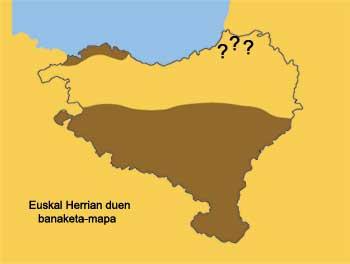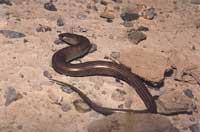Tridáctilo spelt, saurus with hardly legs

When we talk about reptiles of Euskal Herria we always talk about lizards and lizards on one side, and snakes on the other. And the reason is clear: the first are numerous and visionary even in our nearest neighborhood, and the second are endless myths and beliefs, usually without any reason. But besides lizards, lizards and snakes, in our country there are other reptiles.
The Scincidae family is a large group of about 1,300 species classified in 85 genera, whose members are found in tropical and temperate regions around the world: Central America, Central and South America, North and Central America, all Africa and Oceania, South Asia and Europe, in the Mediterranean region. Given the size and extent of the group, it is not surprising that the corner operators exploit a wide variety of habitats. That is why they can be found in very different environments, from deserts to jungles. On the other hand, we have several terrestrial species, other arboreal species and an industrial life machine.

The only species that lives in Euskal Herria is the tridáctilo spelt (Chalcides chalcides chalcides). At first glance the tridactile corner is an elongated reptile similar to the circus, with a maximum total length of 40 cm. The most characteristic feature of this animal is its short length of a few millimeters and, as its name indicates, has three fine fingers provided with nails in each of them.
Despite being extremely short, the tridactile corner is capable of jumping and sliding quickly. Although it hardly uses legs when it circulates for nothing, it is a very slender species, in which the trunk moves from one side to the other, taking as support all wrinkle or lump of the soil, it moves quickly through the waves, as do the snakes and the enas. Taking into account this model of movement and the brevity of the sonorous, it is not surprising that people have often considered it as a snake, but if we look at it in a closer way we can notice that it has eyelids, which indicates its proximity to the lacerids of the skins, at the time that it differentiates us from the serpents.
On the other hand, tridáctilo skiing is dressed in small, shiny smooth scales on the dorsal part, with larger scales in the belly. In addition, and as for its color, it is usually yellowish grey, light brown or pale olive in the dorsal part and rib, with 9-11 lighter longitudinal lines throughout the body. The ventral zone, however, is usually light grey or whitish.
As for the life of the animal, and as it happens in most reptiles that inhabit our region, tridáctilo ski is also a delicious and earthly animal. In the morning, and when the first lights have the lightly temperate floor, it leaves its shelter and sunsets gently. Once the optimal temperature is reached, it will be dedicated to search forage and, being a fervent insectivore, mainly capture coleoptera, arachnids, lepidopteran larvae, isopods, ortópteros, dipteros, etc. But despite being a predator, the corner does not show any kind of aggression, and escapes at full speed above all what he considers enemy.

The zeal of the corner begins in spring, time when strong confrontations occur, plunging into a strong competition to cover females. As it happens in many other corner, the tridáctilo ravine is also ovíparo, so the female will leave from 4 to 15 km in the last weeks of the summer. Newborns only have a length of 7 cm, but before launching into the world they must follow their path while maintaining the challenge of life. And they will have to act quickly if they want to catch and accumulate forces. For the Scottish winter light begins quickly and will remain until April, the longest of reptiles that inhabit our latitude.
As for the distribution of the animal, the tridáctilo spelt is a Mediterranean species that lives in Western Europe — Italy, South France, Sardinia, Kortsika and the Iberian peninsula — and in North Africa. As for the Basque Country, we can say that in the Mediterranean regions of Álava and Navarre, the populations are numerous and widespread. On the coast of Biscay is also resident in a narrow area, with mild and adequate environmental conditions, but its populations appear to be scarce, which may require some effort to ensure its conservation.
The places of residence chosen by this animal in our country are always at low or medium altitudes, from sea level to approximately 1.000 m. In the Mediterranean area is also the fallow and other habitats. On the coast he is a lover of heath and argomals, and is often found in the limits between these and pastures.
Technical details ESKINKO HIRUHATZA Species: Chalcides HouseFamily: Order: Interventions Class: Reptiles reptiles and reptiles |
Buletina
Bidali zure helbide elektronikoa eta jaso asteroko buletina zure sarrera-ontzian











